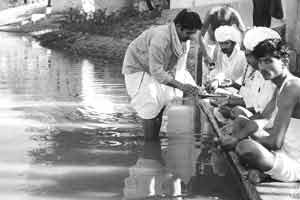| |
NETWORKING |
|
| Strengthening the water bond Continuing wisdom Meet some of them... Their impressions Water warrior speak out |
||
FUNDING AGENCY |
||
| Danida watershed development programme (DANWADEP )
India |
||
INITIATIVE |
||
| Little Wonders |
||
REMEMBERING |
||
| The magician without a wand |
||
TRADITION |
||
| Legacies of the past Venishing Madakasr |
||
RESEARCH PAPER |
||
| Cholistan's story |
||
SEE IT TO BELIEVE IT |
||

| Vol. 3 | No. 2 |
April 2001 |
Glimpses of books

edited by Anil Agarwal, Sunita Narain and Indira Khurana, Centre for Science and Environment, New Delhi, 450 pp, Rs 890 (hard cover)
This book presents the efforts and successes of communities from India and other countries in meeting their water demands through capturing rain. It informs about tradition, practices, technologies and policies. The water crisis India and the world over needs no introduction. What has increasingly become obvious is that water is too serious a business to be left to governments alone. The flaws in the current paradigm of meeting water demands through centralised government-aided supply systems that depend heavily on secondary sources of water like rivers and groundwater is increasingly becoming obvious. No longer can rain, the primary source of water, nor the necessity of community involvement be ignored. India had a long tradition of harvesting rains which Centre for Science and Environment (CSE) 1997 publication Dying Wisdom: Rise, Fall and Potential of India’s Traditional Water Harvesting Systems, documented. This book divided India into its various ecological zones and then looked at the various systems that existed in these ecological zones. It looked at the reasons for the decline of these systems. Realising that there was a need to go beyond tradition and to look at the relevance of these age-old traditions today, in 1998, CSE organised an international conference on Potential of Water Harvesting: Technologies, Policies and Social Mobilisation. The book is based on the over 90 papers that were presented at the conference. These papers included traditional and practices from India, Nepal, Bangladesh, Pakistan, Sri Lanka, Singapore, Southeast Asia, Germany and Japan. But the book goes beyond the conference. Water harvesting efforts had been made in countries like Japan, China and Pakistan which were not covered in the conference. So efforts were made to incorporate these. Quality issues, not addressed in the conference were also included. Meanwhile, the monsoon of 1999-2000 had failed. State government of Andhra Pradesh, Madhya Pradesh and Gujarat initiated crash community-based water harvesting programmes. These programmes were monitored by CSE researchers and their reports are also included. The Gujarat government’s initiated a programme wherein they planned to construct 2,500 check dams through people’s participation. The response they got was astounding and resulted in the construction of over 10,000 check dams. The book describes about the innovations by people in their struggle to meet water demands. Examples are diverse as are solutions, stretching from Ladakh in the north to Kerala in the south and covering the desert, Deccan Plateau, Western Ghats, Eastern Ghats and the coastal plains in between. It informs about how the river Arvari in Rajasthan became alive due to the water that was trapped and allowed to percolate underground due to water harvesting structures and how the village communities along the banks of the river then formed a river parliament to manage it. It informs about how recharge structures in Gujarat harvest more than their constructed capacity. It informs about the traditional tanks in Bundelkhand, neglected and ignored, which still contribute to ‘modern’ water supply systems. It informs about the struggles and triumphs of civil society in Udaipur and Hyderabad in saving their urban waterbodies.
But water harvesting is not meant for the rural areas alone. Urban areas the world over are finding it useful to recharge groundwater, meet water demands and to reduce urban flooding - the result of concretisation. Germany gives tax benefits to practitioners of rainwater harvesting while Japan offers subsidies. In Singapore, a country with an area less than Delhi and the highest population density in the world, roughly about 50 per cent of the urban area is used as catchment. In Chennai a lot of the urban water harvesting ha been directed towards keeping salinity intrusion into the groundwater at bay. The book is not about water or water harvesting structures alone. Indeed, water harvesting is more than just building structures. It is about rebuilding the relationship that people have had with water. It involves building up of the social capital through a process of social mobilisation of the people so that communities act together on the issue of water. This community action then instills confidence within the community, empowering them to act on other issues that are important. It is about solidarity, not conflict. It is about eradicating poverty through rural ecological regeneration. The most beautiful thing about any decentralised water management paradigm is that it not only promotes mass action – not mass production but production by the masses – but also a myriad of innovation. So if in Ladakh artifical glaciers are created to ensure that water is available on time for agriculture, in Karnataka a network of farm ponds improves the soil moisture regime. The book has been dedicated to the all those who have strived to make Mahatma Gandhi’s dream of gram swaraj come true. |
